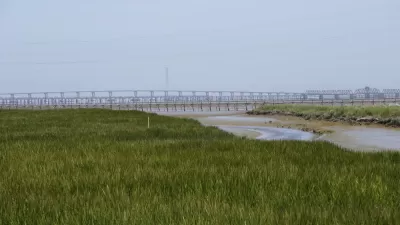The U.S. Environmental Protection Agency and the Army Corps of Engineers have drafted a new Clean Water Rule to clarify the regulatory powers of the Clan Water Act. In response, some members of Congress authored opposing legislation.
"Recently, a number of Senators, led by Senator John Barrasso (R-Wyo.), introduced a bill to kill the Environmental Protection Agency and Army Corps of Engineers' Clean Water Rule," according to an article by Jon Devine. Senator John Barraso (R-WY) and Joe Donnelly (D-IN) authored the new bill, called the "Federal Water Quality Protection Act," in response to the ongoing Clean Water Rule rulemaking process. The U.S. EPA sent a draft of the Clean Water Rule—which would clarify the types of streams and wetlands protected under the federal Clean Water Act—for interagency review in April 2015.
Devine's purpose it to analyze the new bill and to make it clear that the Natural Resources Defense Council opposes the bill. The post goes into detail about the new bill by listing several false premises and several barriers to protection created by the bill. The NRDC's argument, however, boil down to this: the new legislation will make it harder to protect streams, wetlands, and isolated waters.
In April, a blog post by Gina McCarthy, administrator of the U.S. EPA, and Jo-Ellen Darcy, assistant secretary of the U.S. Army Corps, made the case for the draft Clean Water Rule. Environmentalists and the U.S. EPA have been using #CleanWaterRules to advocate for the approval of the draft version of the rule.
Meanwhile, the National Association of Wheat Growers and the U.S. Chamber of Commerce have already expressed support for the Federal Water Quality Protection Act. The golf industry went on the record in September 2014 in opposition to the Clean Water Rule, joining a coalition of opposed business and agricultural interests.
FULL STORY: A Dirty Dozen: Twelve Reasons to Reject New Anti-Clean Water Legislation

Planetizen Federal Action Tracker
A weekly monitor of how Trump’s orders and actions are impacting planners and planning in America.

Congressman Proposes Bill to Rename DC Metro “Trump Train”
The Make Autorail Great Again Act would withhold federal funding to the system until the Washington Metropolitan Area Transit Authority (WMATA), rebrands as the Washington Metropolitan Authority for Greater Access (WMAGA).

The Simple Legislative Tool Transforming Vacant Downtowns
In California, Michigan and Georgia, an easy win is bringing dollars — and delight — back to city centers.

The States Losing Rural Delivery Rooms at an Alarming Pace
In some states, as few as 9% of rural hospitals still deliver babies. As a result, rising pre-term births, no adequate pre-term care and "harrowing" close calls are a growing reality.

The Small South Asian Republic Going all in on EVs
Thanks to one simple policy change less than five years ago, 65% of new cars in this Himalayan country are now electric.

DC Backpedals on Bike Lane Protection, Swaps Barriers for Paint
Citing aesthetic concerns, the city is removing the concrete barriers and flexposts that once separated Arizona Avenue cyclists from motor vehicles.
Urban Design for Planners 1: Software Tools
This six-course series explores essential urban design concepts using open source software and equips planners with the tools they need to participate fully in the urban design process.
Planning for Universal Design
Learn the tools for implementing Universal Design in planning regulations.
Smith Gee Studio
City of Charlotte
City of Camden Redevelopment Agency
City of Astoria
Transportation Research & Education Center (TREC) at Portland State University
US High Speed Rail Association
City of Camden Redevelopment Agency
Municipality of Princeton (NJ)




























